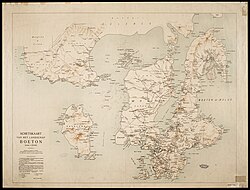
Sultan is a position with several historical meanings. Originally, it was an Arabic abstract noun meaning "strength", "authority", "rulership", derived from the verbal noun سلطة sulṭah, meaning "authority" or "power". Later, it came to be used as the title of certain rulers who claimed almost full sovereignty without claiming the overall caliphate, or to refer to a powerful governor of a province within the caliphate. The adjectival form of the word is "sultanic", and the state and territories ruled by a sultan, as well as his office, are referred to as a sultanate.

The Malacca Sultanate was a Malay sultanate based in the modern-day state of Malacca, Malaysia. Conventional historical thesis marks c. 1400 as the founding year of the sultanate by King of Singapura, Parameswara, also known as Iskandar Shah, although earlier dates for its founding have been proposed. At the height of the sultanate's power in the 15th century, its capital grew into one of the most important transshipment ports of its time, with territory covering much of the Malay Peninsula, the Riau Islands and a significant portion of the northern coast of Sumatra in present-day Indonesia.
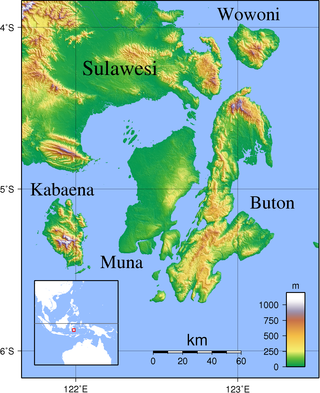
Buton is an island in Indonesia located off the southeast peninsula of Sulawesi. It covers roughly 4,727 square kilometers in area, or about the size of Madura; it is the 129th largest island in the world and Indonesia's 19th largest in area.

Sultan of Selangor is the title of the constitutional ruler of Selangor, Malaysia who is the head of state and head of the Islamic religion in Selangor. The current monarch, Sultan Sharafuddin Idris Shah ascended the throne on the death of his father, on 22 November 2001.

Baubau is a city in Southeast Sulawesi province, Indonesia. The city is located on the southwest coast of Buton island. Baubau attained city status on 21 June 2001, based on Law Number 13 of 2001. It covers an area of 294.98 km2, including about 30 km2 of water area, and had a population of 136,991 at the 2010 Census and 159,248 at the 2020 Census; the official estimate as at mid 2023 was 161,280. The city is the economic center of Buton Island region and the second largest city in the province. It was cultural center of Butonese people and former capital of Sultanate of Buton, colonial administration of Eastern Sulawesi, and for a brief moment the entire Southeast Sulawesi until 1955 when the capital status and economic development shifted to neighbouring Kendari.

Kutai is a historical region in what is now known as East Kalimantan, Indonesia on the island of Borneo and is also the name of the native ethnic group of the region, numbering around 300,000 who have their own language known as the Kutainese language which accompanies their own rich history. Today, the name is preserved in the names of three regencies in East Kalimantan province which are the Kutai Kartanegara Regency, the West Kutai Regency and the East Kutai Regency with the major river flowing in the heart of the region known as the Mahakam River. Kutai is known to be the place of the first and oldest Hindu kingdom to exist in East Indies Archipelago, the Kutai Martadipura Kingdom which was later succeeded by the Muslim Kutai Kartanegara Sultanate.
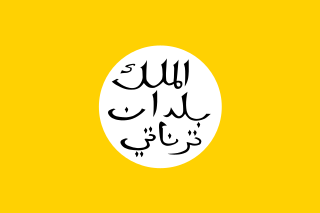
The Sultanate of Ternate, previously also known as the Kingdom of Gapi is one of the oldest Muslim kingdoms in Indonesia besides the sultanates of Tidore, Jailolo, and Bacan.
The Muna–Buton languages are a group of languages spoken on the islands of Muna and Buton off the coast of South East Sulawesi province, Indonesia. They belong to the Celebic subgroup of the Austronesian family.
Cia-Cia, also known as Buton or Butonese, is an Austronesian language spoken principally around the city of Baubau on the southern tip of Buton island, off the southeast coast of Sulawesi, in Indonesia. It is written using the Latin and Hangul scripts.
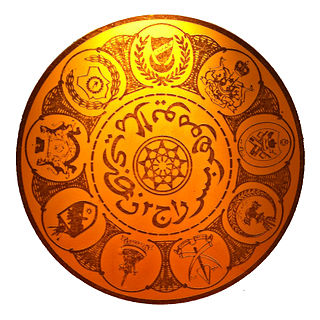
The monarchies of Malaysia exist in each of the nine Malay states under the constitutional monarchy system as practised in Malaysia. The political system of Malaysia is based on the Westminster parliamentary system in combination with features of a federation.

Buri Wolio is an Arabic script modified to write Wolio, a language spoken in and around Baubau, the capital of Buton, Southeast Sulawesi, Indonesia. Generally, this script is same with Jawi script, except in Buri Wolio, vowel sounds are symbolized. This script has 35 letters, 28 letters from Arabic alphabet and 7 additional letters similar to those in Jawi script to represent sounds not found in Arabic. Of these, 22 are used for writing of Wolio language, while 13 are reserved for writing loanwords of Arabic origin.
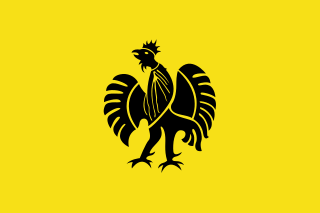
The Sultanate of Gowa was one of the great kingdoms in the history of Indonesia and the most successful kingdom in the South Sulawesi region. People of this kingdom come from the Makassar tribe who lived in the south end and the west coast of southern Sulawesi.

The Butonese people is a collective term that embraces a number of ethnic groups of Buton and neighbouring islands in Southeast Sulawesi. Like many other ethnic groups in Sulawesi, the Butonese are seafarers and traders. Butonese have long since migrated to many parts of the Malay archipelago using smaller vessels ranging from those that can only accommodate five people to large boats that can hold up to about 150 tons of goods. In general, the Butonese are a community that inhabits the region of the historical Buton Sultanate. When the swapraja domain was abolished, so did the Buton Sultanate which ended in 1951. The area of the former Sultanate is now distributed over several regencies and cities of Southeast Sulawesi. Among them are Baubau, Buton Regency, South Buton Regency, Central Buton Regency, North Buton Regency, Wakatobi Regency and Bombana Regency.
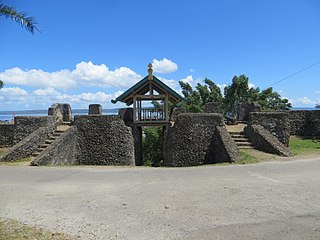
Buton Palace Fortress, originally the Wolio Palace, is a late 16th century palatial fortress located in Baubau, Southeast Sulawesi. The palace was built in the late 16th century for Sultan Buton III, La Sangaji titled Sultan Kaimuddin (1591-1596) and was the residence of the Buton Sultanate. Heritage performances are given inside the fortress.
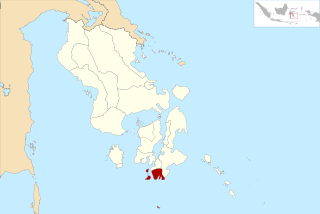
South Buton Regency is a regency located on Buton Island in Southeast Sulawesi Province of Indonesia. This regency was formed from the southern part of Buton Regency, from which it was separated by Act No.16 of 2014, dated 23 July 2014. It covers an area of 546.58 km2, and the population of the districts now comprising the new regency was 74,974 at the 2010 Census and 95,261 at the 2020 Census; the official estimate as at mid 2023 was 101,635. The regency capital is located in Batauga.

The Kingdom of Banggai was a petty kingdom in present-day Central Sulawesi, Indonesia. It was based around the Banggai Islands and the eastern coast of Sulawesi, centered at the island of Banggai. For a significant part of its history, the kingdom was under the overlordship of the Sultanate of Ternate. Its' rulers held the title of Raja.

Al-Hilal Mosque or Al Hilal Old Mosque of Katangka, better known as Katangka Mosque, is a historical mosque in South Sulawesi, Indonesia. Constructed in 1603 by the first Muslim ruler of the Sultanate of Gowa, Sultan Alauddin, the mosque is considered the oldest mosque in South Sulawesi.

The Mempawah Kingdom also known as the Mempawah Sultanate, was an Islamic Dayak kingdom located in a territory now known as the Mempawah Regency, West Kalimantan, Indonesia. The name Mempawah is taken from the term "Mempauh", which is the name of a tree that grows in the upper reaches of the river, also known as the Mempawah River. In its development, Mempawah became known as the name of one of the kingdoms and sultanates that developed in West Borneo. The history of Mempawah is divided into two periods, namely the Dayak kingdom based on Hindu teachings and the period of Islamic influence.
